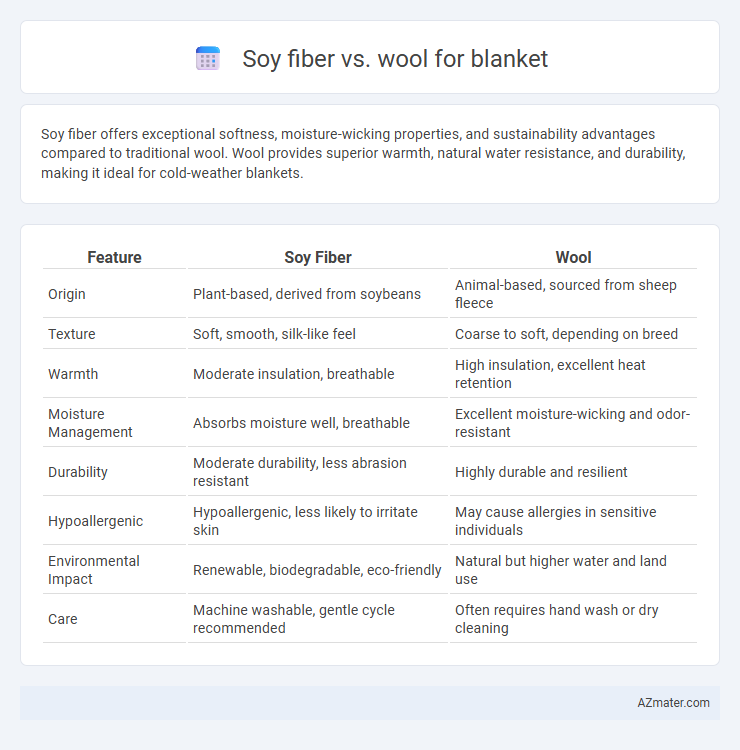Soy fiber offers exceptional softness, moisture-wicking properties, and sustainability advantages compared to traditional wool. Wool provides superior warmth, natural water resistance, and durability, making it ideal for cold-weather blankets.
Table of Comparison
| Feature | Soy Fiber | Wool |
|---|---|---|
| Origin | Plant-based, derived from soybeans | Animal-based, sourced from sheep fleece |
| Texture | Soft, smooth, silk-like feel | Coarse to soft, depending on breed |
| Warmth | Moderate insulation, breathable | High insulation, excellent heat retention |
| Moisture Management | Absorbs moisture well, breathable | Excellent moisture-wicking and odor-resistant |
| Durability | Moderate durability, less abrasion resistant | Highly durable and resilient |
| Hypoallergenic | Hypoallergenic, less likely to irritate skin | May cause allergies in sensitive individuals |
| Environmental Impact | Renewable, biodegradable, eco-friendly | Natural but higher water and land use |
| Care | Machine washable, gentle cycle recommended | Often requires hand wash or dry cleaning |
Introduction: Choosing the Right Blanket Material
Soy fiber blankets offer a sustainable, hypoallergenic alternative with natural moisture-wicking properties and a silky softness that enhances comfort. Wool blankets provide exceptional warmth, breathability, and durability, naturally regulating temperature and resisting odors. Selecting between soy fiber and wool depends on preferences for eco-friendliness, insulation needs, and skin sensitivity.
Understanding Soy Fiber: Composition and Benefits
Soy fiber, derived from soybean protein, offers a soft, breathable, and eco-friendly alternative to traditional wool in blankets. Its natural composition ensures moisture-wicking and hypoallergenic properties, making it ideal for sensitive skin and temperature regulation. While wool provides warmth and durability, soy fiber excels in sustainability and smooth texture, appealing to environmentally conscious consumers.
Wool Blankets: Traditional Warmth and Features
Wool blankets provide exceptional warmth and natural insulation due to the fiber's ability to trap air, making them ideal for cold climates. The moisture-wicking properties of wool keep users dry and comfortable by absorbing humidity without feeling damp. Wool fibers are also naturally elastic and durable, offering long-lasting softness and resistance to wrinkles compared to soy fiber blankets.
Softness and Texture: Soy Fiber vs Wool
Soy fiber blankets offer a smooth, silky texture with exceptional softness, making them gentle on sensitive skin and ideal for lightweight comfort. Wool blankets provide a naturally coarse yet cozy texture, delivering superior warmth and breathability with a slightly firmer feel. Choosing soy fiber ensures a soft, luxurious touch, while wool guarantees durable insulation and textured warmth.
Warmth and Insulation Comparison
Soy fiber blankets provide moderate warmth with excellent breathability, making them ideal for temperate climates where moisture regulation is important. Wool blankets excel in warmth and insulation due to natural crimped fibers trapping air, which retains heat efficiently even in damp conditions. The thermal resistance of wool outperforms soy fiber, ensuring superior cold-weather protection and moisture-wicking capabilities.
Breathability and Moisture-Wicking Properties
Soy fiber blankets excel in breathability due to their natural cellulose structure, allowing superior air circulation that keeps users cool. Wool blankets possess excellent moisture-wicking properties, absorbing up to 30% of their weight in moisture while maintaining warmth, making them ideal for varying temperatures. Combining soy fiber's ventilation with wool's moisture management offers a balanced comfort solution for blankets.
Eco-Friendliness and Sustainability
Soy fiber blankets are highly eco-friendly, derived from soybean hulls, which are a renewable and biodegradable byproduct of soybean processing, reducing agricultural waste. Wool blankets come from sheep, a natural and renewable resource, but their sustainability can vary due to land use, methane emissions, and water consumption related to sheep farming. Both fibers offer biodegradable options, but soy fiber's plant-based origin typically results in a lower overall environmental footprint compared to animal-derived wool.
Allergy Concerns: Hypoallergenic Considerations
Soy fiber blankets are naturally hypoallergenic, making them an excellent choice for individuals with sensitive skin or allergies, as they resist dust mites and mold. Wool blankets, while warm and durable, can sometimes trigger allergic reactions or skin irritation due to lanolin content and shedding fibers. For allergy-conscious consumers, soy fiber provides a gentler, irritation-free alternative, enhancing comfort without compromising warmth.
Care, Maintenance, and Durability
Soy fiber blankets offer easy care, being machine washable and resistant to shrinking, making maintenance straightforward for everyday use. Wool blankets require gentle handling, often needing hand washing or dry cleaning to preserve their natural fibers and prevent felting, which impacts durability. Wool's innate resilience and elasticity provide superior long-term durability compared to soy fiber, which can wear out faster under frequent washing.
Price and Value: Which Blanket Material Wins?
Soy fiber blankets generally offer a more affordable price point compared to wool, making them an attractive option for budget-conscious consumers. Wool blankets provide superior warmth and durability, often justifying their higher cost with long-term value and natural insulation properties. When evaluating price versus value, soy fiber blankets win for economical choices, while wool blankets excel in performance and longevity.

Infographic: Soy fiber vs Wool for Blanket
 azmater.com
azmater.com